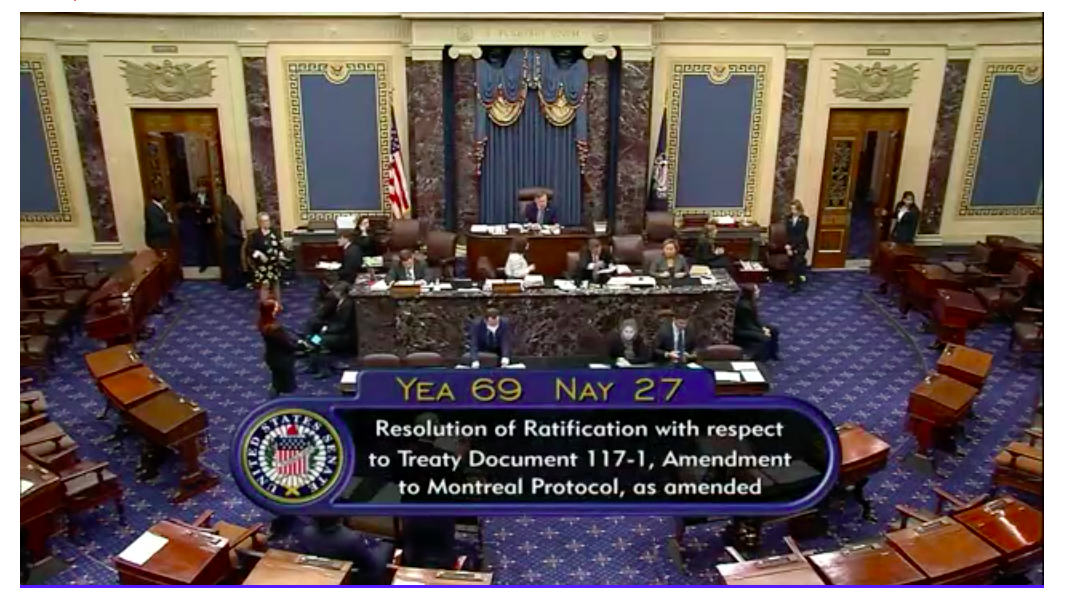US Senate Votes to Ratify Kigali Amendment to Phase Down Super Polluting HFCs

Reducing HFCs avoids up to 0.5°C of future warming
Climate benefits double with parallel improvements in energy efficiency
21 September 2022, Washington, DC — In a major victory for the planet, the US Senate voted to ratify the Kigali Amendment to the Montreal Protocol to phase down super climate pollutants called hydrofluorocarbons (HFCs), used primarily as refrigerants in air conditioners and other cooling equipment. The Kigali Amendment needed the approval of a two-thirds super-majority of the chamber, which it received with the support of 21 Republican and 48 Democratic Senators. It is the first climate treaty to clear the Senate in decades.
Durwood Zaelke, President of the Institute for Governance & Sustainable Development, said:
“Ratification confirms President Biden’s continuing climate leadership. It also confirms his appreciation of the need for speed to address the climate emergency and the critical role played by cutting HFCs. He and his team know that cutting the short-lived climate pollutants—HFCs, black carbon, methane, and tropospheric ozone—is the only strategy that we are certain can slow warming in the next 20 years.”
“Without the Montreal Protocol civilization would have already completely descended into climate chaos. If ozone-depleting chemicals had not been banned, we would be looking at a global temperature rise of an additional 2.5°C by the end of this century. This would have already pushed our planet past irreversible tipping points. The Kigali Amendment is among our most significant climate wins from the best environmental treaty in the world. US ratification is another huge victory for the planet.”
“When you line up business goals with environmental goals, you can get bipartisan support at home and North-South support globally for stronger multilateralism. We need to learn from the Montreal Protocol and apply the lessons more broadly to have a fighting chance to keep the climate safe.”
After nearly a decade of talks, the Kigali Amendment to the Montreal Protocol was agreed by the Parties in October 2016 to phase down super polluting HFCs. The Amendment, first championed by the Federated States of Micronesia and other low-lying island states, represents the single biggest piece of climate mitigation to date—and the only piece under a mandatory treaty— with the potential to avoid up to 0.5°C of future warming. Beyond phasing down HFCs, improving the energy efficiency of cooling equipment has the potential to at least double the climate benefits of the Kigali Amendment in the near term.
A 2018 industry report forecast that phasing down HFCs in the U.S. will also increase exports, create 150,000 more American jobs, generate billions in new investments, and save American consumers $3.7 billion over 15 years.
As part of the year-end spending bill in 2020, Congress already provided federal authority to phase down HFC production and consumption in line with the Kigali Amendment to the Montreal Protocol. Known as the American Innovation and Manufacturing (AIM) Act, the law mandated a reduction in the climate impacts of HFCs produced and consumed in the USA by 85% over the next 15 years, and provided EPA with the authority to regulate HFCs even faster in key sectors.
In 2021 President Biden formally submitted the Kigali Amendment to the Senate for ratification, and the Foreign Relations Committee advanced it out of committee with bipartisan support earlier this summer. On Tuesday, the Senate voted 64-30 in favor of a procedural motion to limit debate on ratification that teed up the final vote on Kigali.
Ratification will allow the US to continue providing political leadership in the Montreal Protocol to do still more climate mitigation, including by reducing the “banks” of HFCs and related refrigerants in cooling equipment at produce end of life, closing the loophole for feedstocks, and adding N2O, the last chemical that destroys stratospheric ozone and causes warming. Ratification allows US industry to continue its leading role in providing climate-friendly substitutes for HFCs.
To date, the Kigali Amendment has been ratified by 137 Parties, including China and India. The Senate’s ratification also declared that China was no longer a developing country and should not be treated as such and that the US should submit a proposal to the Montreal Protocol to clarify this. The treaty makes decisions by consensus, and China and all other Parties will have to agree that it’s time for China to graduate.
NOTE: The Montreal Protocol was first signed by President Reagan in 1987, and approved unanimously by the Senate in 1988; the previous four amendments also were approved unanimously by the Senate. The treaty is widely regarded as the most successful global environmental treaty.
Over its 35 years of operation, the Montreal Protocol has phased down nearly 100 chemicals that damage the stratospheric ozone layer by nearly 100% and put the protective ozone layer on the path to recovery.
Because the chemicals, including CFCs and HCFCs, also warm the planet, the Montreal Protocol, together with earlier consumer boycotts and related national measures to control these chemicals, has avoided warming that otherwise would have equaled or exceeded the warming carbon dioxide is causing today, which is a bit more than half of global warming. According to United Nations Environmental Programme, “if ozone-depleting chemicals had not been banned, we would be looking at a global temperature rise of an additional 2.5°C by the end of this century. This would have been a catastrophe.”
Although they do not destroy the ozone layer, HFCs also are powerful climate pollutants, part of the short-lived climate pollutants which include methane, tropospheric ozone, and black carbon soot.
Cutting short-lived climate pollutants in the next decade can cut the rate of climate warming by half and Arctic warming by two-thirds, a critical strategy for keeping the planet safe as countries pursue the goals of net-zero climate emissions by 2050.
